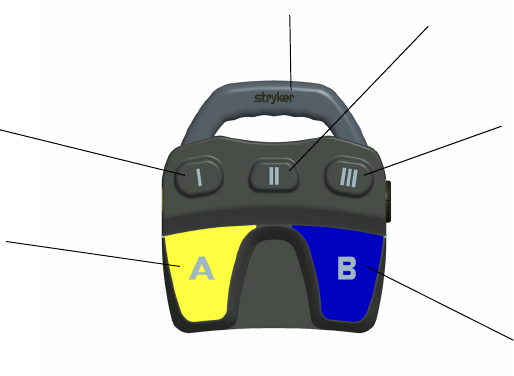User's Manual
Table Of Contents
- Table of Contents
- Warnings and Cautions
- 1. Read this operating manual thoroughly and be familiar with its contents prior to using this equipment.
- 2. Carefully unpack the unit and check if any damage occurred during shipment. If damage is detected, please refer to the Service section in this manual.
- 3. Avoid removing covers on the unit and attempting internal repairs or adjustments not specifically detailed in this operating manual.
- 4. Pay close attention to the care and cleaning instructions in this manual. A deviation may cause damage to the device.
- 5. Never sterilize the Wireless Universal footswitch components.
- 6. Be completely familiar and comfortable with the operation of the Wireless Universal footswitch. Training may be required before some operators are thoroughly familiar with how to properly operate the footswitch.
- 7. When the Receiver is interconnected with other medical electrical equipment, leakage currents may be additive. Ensure all systems are installed according to the requirements of IEC 60601-1-1.
- Symbol Definitions
- Product Description and Intended Use
- 1. A wireless footswitch, which provides pedals similar to those found on other footswitches and transmits radio signals to a radio receiver console
- 2. A radio receiver console, which routes commands from the footswitch to devices that connect to the receiver’s rear panel.
- The Footswitch
- The Receiver
- Front Panel
- 1. Power Switch: Powers on and off the receiver. The switch will illuminate when the unit is on.
- 2. Synchronize port 1: Enables a footswitch to work with the receiver when aligned with the synchronize logo on that footswitch. The footswitch will be designated as “footswitch 1.”
- 3. Mode button 1: Selects which device footswitch 1 will control (which “mode” the footswitch is in). Pressing and holding this button will clear the Footswitch.
- 4. Active-device display 1: Displays which device is currently active and can be controlled by footswitch 1 (which “mode” footswitch 1 is in).
- 5. Active-device display 2: Displays which device is currently active and can be controlled by footswitch 2 (which “mode” footswitch 2 is in).
- 6. Mode button 2: Selects which device footswitch 2 will control (which “mode” the footswitch is in). Pressing and holding this button will clear the Footswitch
- 7. Synchronize port 2: Enables a second footswitch to work with the receiver when aligned with the synchronize logo on that footswitch. The footswitch will be designated as “footswitch 2.”
- Rear Panel
- 1. TPS output: Provides a dedicated connection to the TPS console, enabling the commands issued from the footswitch to be routed to the TPS console.
- 2. SERFAS output: Provides a dedicated connection to the SERFAS console, enabling the commands issued from the footswitch to be routed to the SERFAS console.
- 3. Expansion port: Provides a generic connection to addition devices, enabling the commands issued from the footswitch to be routed to the console.
- 4. Expansion port: Provides a generic connection to addition devices, enabling the commands issued from the footswitch to be routed to the console.
- 5. SFB Serial Connectors: Enables firewire connection with newer devices, such as CORE and SERFAS Energy, eliminating the need for multiple connection cables.
- 6. Volume control: Controls the output volume.
- 7. AC-power input: Connects to the AC Power cord, which connects to a hospital-grade power outlet.
- Setting up the iSwitch
- footswitch Receiver
- Reverse
- Cut
- Using the Receiver Controls
- Cleaning and Maintenance
- Troubleshooting
- Technical Specifications
- Electromagnetic Compatibility
- Warranty
- Service and Claims
- 1. Contact Stryker Endoscopy at 1-800-624-4422, or phone your local Stryker Endoscopy sales representative.
- 2. Clean and sterilize all parts that will be returned for service. Follow the instructions provided in this manual.
- 3. Package all the components carefully in the original shipping container if possible.
- 4. Ship the unit, pre-paid and insured to:
- Other Service

5
The Footswitch
The footswitch rests on the operating-room floor and provides foot control of all
devices connected to the iSwitch system. The footswitch houses three buttons
and two pedals, which enable the user to alternate between operating-room
devices and perform device-specific functions. When a button or pedal is pressed,
the footswitch transmits a radio signal to the receiver, where the command is then
routed to the appropriate device.
The footswitch and its features are described in Figure 2 below.
Figure 2: The footswitch
1. Footswitch Handle
2. Button II (Mode Button): Selects which device the footswitch will
control. See the “System Settings” section of this manual for Mode
options.
Note Button/pedal function for all other buttons and pedals depends
on which operating-room device, or “mode,” is selected. See the
“Using the footswitch controls” section in this manual for device-
specific button functions.
3. Button III
4. Pedal B
5. Pedal A
6. Button I
1
2
4
5
6
3










